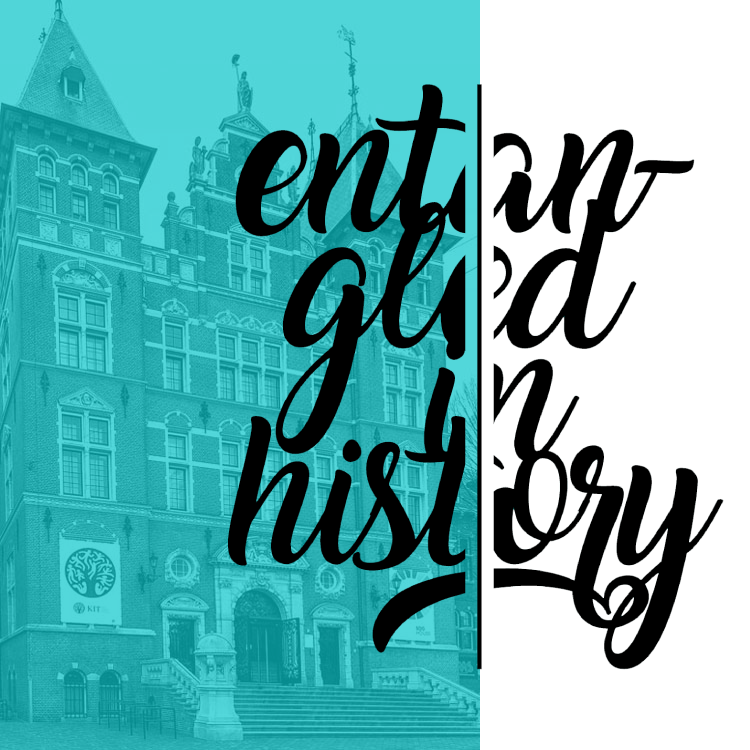
Introduction: entangled in history
Amsterdam is an enormous, tangible record of the Dutch colonial past. As one of the centres of Europe’s colonial expansionism globally, the city retains a web of memories spread throughout the city. Some obvious examples are the street names in the Dapper, Transvaal or the ‘Indies’ neighbourhoods to the east of the city. It is here that we find the building of the Koninklijk Instituut voor de Tropen (Royal Tropical Institute, KIT), an inherently colonial building.
Embodying stories
Today’s KIT and Tropenmuseum were formerly the nineteenth century Koloniaal Instituut (Colonial Institute) and its accompanying Koloniaal Museum (Colonial Museum). Inside and out, everywhere are sculptures, paintings and other decorative elements embodying stories of the Netherlands and its colonies, the Dutch East Indies in particular (present day Indonesia). These decorations give an impression of the dominant ideologies at the time of construction, between 1915 and 1926. Several elements of those theories and ideologies of a supposed European superiority, and the inequalities and hierarchies of that time, continue to permeate society today.
Case study
The interior of the building and what takes place in it, have changed over time. The exterior, however, continues to recall colonial times, as well as to reflect Amsterdam’s and the Netherlands’, often asymmetrical, relations to a world that this building helped to shape after decolonialisation. Brimming with colonial symbolism, it provides an important case study for how we could approach the Dutch colonial past. What relevance does a building such as this have for our current moment? How should we deal with these traces of colonialism, as institutions and as a society? These are the questions that inspired this guide.
The Vereeniging Koloniaal Instituut (Colonial Institute Society) initiated the building’s construction in 1910. They wished to create a place for the ‘promotion of trade, agricultural and industrial interests arising from our Dutch colonial possessions’. To ensure that the physical form aligned with this goal, a separate committee worked with the architects to design ornamentation that ‘testified to the importance of our colonial possessions and the building’s purpose’.
Address critical perspectives
While these decisions were made over a century ago, the ornaments remain as testament to this day. Dutch colonial history is deeply entwined with the fabric of the building, carrying the past into the present. With growing criticism from outside, but also from inside institutions, the society has become increasingly aware of the contested nature of such material and immaterial colonial legacies. How should we deal with monuments, images and names from the colonial period? How do we treat words and phrases that are now seen as racist, discriminatory or promoting one-sided dominant perspectives? While terms such as ‘science’ and ‘development’ may have been considered to be neutral in the past, and sometimes still are, they are actually heavily loaded in practice. We are currently reassessing the ideologies that underlie such terms. We want to address these critical perspectives. This guide is thus part of a longer-term project by the KIT and the Tropenmuseum to promote open discussion in order to address and confront these legacies.
The building’s imagery focuses mainly on colonial production and trade, the arts, local religions and missionary activities, and the sciences: cultural and physical anthropology, healthcare, education, Oriental studies and history. This imagery is steeped in the coloniser’s sense of authority and superiority. In the Netherlands, as with other (past) colonial powers, buildings, monuments and street names helped to set these powers in stone. They presented as fact what was considered self-evident at the time: a ‘modern’ European state’s right to subjugate ‘traditional’ societies overseas. This imagery also legitimized the Koloniaal Instituut’s activities, with scientific departments for agricultural, medical and ethnographic research that relied partly on the museum’s collections. It is this self-evidence, this legitimacy, that is rightly receiving increasing criticism.
Self-interest and conceit
Additionally, the building illustrates the self-interest and conceit that underpinned the Dutch ‘ethical policy’ and ‘civilising mission’. This mission, which was represented as an acknowledgement of the moral debt owed to the then Dutch East Indies, aimed to improve the social and economic situation of the local population, though under conditions defined and determined by the coloniser. But in whose interest was this, truly? This approach to improvement, through for example irrigation, emigration and education is most clearly visible in the mural De Samenwerking (The Collaboration, see Decorative Element #3). However, both the ethical policy and its presumed ideals were already criticized at the time as supportive of the perpetuation of the Dutch colonial project.
Onesided perspective
In 2003, the building of the Koloniaal Instituut was declared a national monument, to be protected as part of Dutch heritage. One could ask why such a colonial monument specifically merits this type of preservation. In this guide, we hope to complicate the onesided perspective offered by the building, and by so many other monuments from the colonial period. We want to show how the past can help to explain and improve our understanding of the present, but also to discuss how our perspectives about the past can change with time.
Changing views
The building represents a period in which European powers justified colonialism through a firm belief in their own cultural superiority. Over a century after the founding of the Institute and its museum, views on colonialism and its symbolism have changed. There is growing criticism of colonialism’s systems of suppression, inequality, violence and exploitation, criticism of the so called ‘Golden Age’ and ‘civilizing mission’ in history. And rightfully so. In the years following 1945, when Indonesia claimed its independence, the building gradually became a historic backdrop for evolving policies. The Koloniaal Instituut changed its name and its successor, the Koninklijk Instituut voor de Tropen (Royal Tropical Institute, KIT), has become a centre for what used to be called development aid, later international aid. Today, a desire to promote global equality and sustainable development drives the KIT to focus on the UN’s Sustainable Development Goals (SDGs).
The exterior of this monumental building remains nigh unchanged in all its symbolism. In many respects this reflects parts of society’s views of colonialism. To some, colonialism is merely ‘history’, it is of the past, and the building’s colonial associations are fading from collective memory.
Facing colonial past
Against the backdrop of popular and academic concerns about the silencing, even forgetting, of colonialism in the national consciousness, the Institute and the museum also face ongoing questions about their links to the colonial past. How are we to deal with the building’s entanglement with this past? The Institute and museum have long been aware of this question. We have attempted to grapple with the past in various ways; attempts that we now, admittedly, can agree have been inadequate and insufficiently critical. With this guide, we now revisit the building and its imagery, locating it within contemporary debates around how to deal with the colonial past in the present. In doing this, we bring into question an earlier told story of the Dutch as (self-declared) natural recipients of the world’s riches and of a self-proclaimed superiority to those colonised lives that were regarded as less valuable under this global economic system.
Replace old narratives
The fact that such unequal and unfair relations are recorded in stone, wood and paint inspires fierce debate on many fronts. And so should it. Should these images be removed? Do they reinforce colonial stereotypes and glorify perpetrators of historical injustice, or do we actually need such testimonies from the past to be able to reckon with colonial legacies? If we can learn to view these legacies differently, can they tell us a new story? Alternatively, could supplementing them with new images help to replace old narratives for new ones?
Critical (re) interpretations
KIT and the Tropenmuseum opted for the latter approach, as an attempt to complicate the one-sided story. This guide is one of the tools by which we hope to accomplish this goal. We invited artist Brian Elstak to respond to the building’s colonial imagery. His drawings do not simply supplement the existing visual language of the building; they are critical (re) interpretations. Some people may view the building’s decorations for their artistic and historic value alone. To others, however, they are a painful confrontation with the colonial past and its legacies in the present. This guide is not intended to cause further pain, but to help make colonialism more ‘speakable’, to help us reconcile ourselves to this past.
Note: not all the interior decorations mentioned here are publicly accessible. For this reason, all descriptions are accompanied by photographs. We are aware that their reproduction may help to perpetuate contested imagery. However, by showing these images in combination with the works by Brians Elstak, we have made a conscious decision, mindful of the need to foster more critical approaches to and greater awareness of our colonial past.






